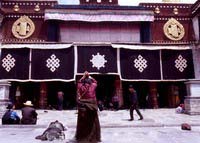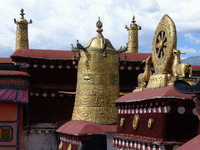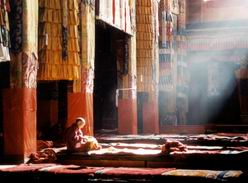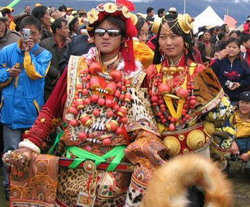Tour code: SWTB001
4 Days Discover Lhasa tour
-
Trip highlights
The Potala Palace the architectural wonder is Lhasa's cardinal landmark. It consists of the White and Red palaces with more than 1000 rooms. The white places was for secular use.
-
Tour price
-
Destinations
Beijing, Lhasa
-
Tour type
Private tour available everyday, private tour guide & driver
Day by Day Itinierary
| Day 1 Beijing, Lhasa ( ) |
| Be met at Lhasa airport by our English speaking tour guide & transferred to your hotel. Free at leisure to acclimatize yourself to the high latituder. |
Lhasa | Lhasa has an elevation of 3650 meters and sits at the center of the Tibet Plateau. It has a history of more than 1300 years. It towers as a huge magnet attracting those who want to explore its culture. Entry into Lhasa allows each traveler the chance to glimpse into Tibet. |
|
 |
| [ Optional ] Ramoche Monastery: it is one of the key cultural relic protection sites in Lhasa, located on the north of Barkhor Street, in the area with a local market and many traditional style Tibetan style civilian houses. |
|
| Day 2 Lhasa ( B,L ) |
| Explore the famous attractions in downtown Lhasa today. |
The Barkhor Street | The Barkhor Street is Lhasa's inner pilgrim circuit shaped roughly like an octagon that runs around the Jokhang. The circuit is lined with markets, shops, stalls and street vendors providing every conceivable item a Tibetan could need. The best place to start the circuit is right outside the Jokhan…… | The Jokhang Temple | The Jokhang Temple is the spiritual centre of Tibet - a destination for millions of Tibetan pilgrims. The oldest part of the temple dates back to the 7th century AD - being one of the two temples built by King Songsten Gampo to house the statues of the Buddha that his two foreign wives brought to Ti…… | The Potala Palace | The Potala Palace is a landmark of Lhasa and Lama Buddism. It is a 13 storey and 1000 rooms' palace and once winter residence of the Dalai Lama. The construction of the present structure began during the reign of the fifth Dalai Lama in 1645 and took more than 50 years to complete. |
|
 |
| [ Optional ] Tibetan Family Visit: Every Tibetan family has been either directly or indirectly affected by the Chinese, Indian and Nepal culture. Family life is one of the most interesting attractions during your stay in Tibet. Common Tibetan people welcome you to their homes, greet you in their traditional way and entertain you with their typical food. |
|
| Day 3 Lhasa ( B,L ) |
| Today's visit is a type of exploring the ancient Tibetan culture, should not be missed in Lhasa. |
The Tibet Museum | The Tibet Museum, located in the southeastern corner of Norbu Lingka, Lhasa, is the first of its kind in Tibet to be provided with the latest in equipment and facilities. The Tibet Museum was completed and opened in October 1999. | Norbulingka | The Norbulingka Park: Norbulingka means "Jeweled Garden". It was constructed as a summer palace for the Dalai Lama at the very beginning and later served as the whole governmental administration. | The Sera Monastery | The Sera Monastery lies on the northern edge of Lhasa at the base of Tatipu Hill. 'Sera' means 'merciful hail' denoting its rivalry with the 'Rice Heap' (Drepong) since hail destroys rice. Sera was smaller than Drepong with about 7,000 monks but was very rich and comparable in power. |
|
 |
| [ Optional ] Tibetan Opera Performance: The Tibetan people are good at singing and dancing. Tibetan opera is called "Ajilamu" in Tibetan which means "sister fairy maiden". It is a kind of public square opera, which has play, vocal music, separate roles, accompanying band and special masks and clothes, and its main form is song and dance. |
|
| Day 4 Lhasa ( B ) |
| Free time in Lhasa. Transfer to airport for your flight to next destination. |
Lhasa Carpet Factory | Lhasa Carpet Factory is a factory south of Yanhe Dong Lu near the University of Tibet in Lhasa the capital of Tibet. It produces traditional Tibetan rugs. The highland of Tibet is the actual home of the oriental carpets. By visiting Carpet Factory you will have a general idea of how carpets are prod…… |
|
 |
| [ Optional ] Qinghai-Tibet Railway: The highest point of the Qinghai-Tibet Railway is the Tanggula Mountain Pass, which is at an altitude more than 5,000 meters above sea level. At this point passengers may experience slight high-altitude-reaction symptoms, such as headaches, but they soon pass as the train heads downward. |
|